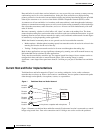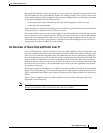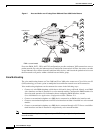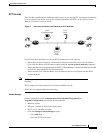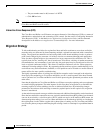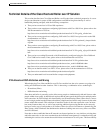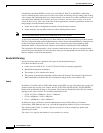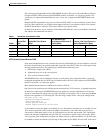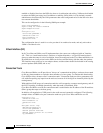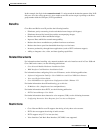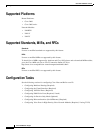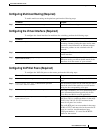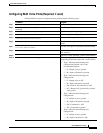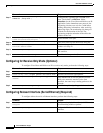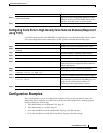
Cisco Hoot and Holler over IP
Feature Overview
10
Cisco IOS Release 12.1(5)T
enabled or disabled, but since the DSPs also have to do arbitration and mixing, VAD must be disabled
to reduce the DSPs processing load. In addition to enabling VAD (which is on by default), network
administrators should modify the VAD parameters that sense background noise so that idle noise does
not consume bandwidth.
This can be configured as in the following E&M port example:
voice class permanent 1
signal timing oos timeout disabled
signal keepalive 65535
!
voice-port 1/0/0
voice-class permanent 1
connection trunk 111
music-threshold -30
operation 4-wire
The configuration above is used for a voice-port that is in send/receive mode, and only noise above
-30Db is considered voice.
Virtual Interface (Vif)
In all Cisco Hoot and Holler over IP implementations, the routers are configured with an "interface
vif1." This is a virtual interface that is similar to a loopback interface—a logical IP interface that is
always up when the router is active. In addition, it must be configured so the Cisco Hoot and Holler over
IP packets that are locally mixed on the DSPs can be fast-switched along with the other data packets.
This interface must reside on its own unique subnet, and that subnet should be included in the routing
protocol updates (RIP, OSPF, and so on).
Connection Trunk
Cisco Hoot and Holler over IP provides an "always-on" communications bridge—end users do not need
to dial any phone numbers to reach the other members of a hoot group. To simulate this functionality,
Cisco IOS provides a feature called "connection trunk." Connection trunk provides a permanent voice
call, without requiring any input from the end user, because all of the digits are internally dialed by the
router/gateway.
With traditional VoIP usages of connection trunk, the call is mapped to a remote router/gateway, and all
the H.323 signaling is handled dynamically when the trunk is established. With
Cisco Hoot and Holler over IP, the connection trunk is established to the IP address of the IP multicast
(IPmc) group that maps to the hoot group.
In addition, all negotiation of UDP ports for the audio stream is manually configured. The following
example shows an E&M voice port connection trunk set up for Cisco Hoot and Holler over IP:
voice-port 1/0/0
connection trunk 111
music-threshold -30
operation 4-wire
!
dial-peer voice 1 voip
destination-pattern 111
voice-class permanent 1
session protocol multicast
session target ipv4:237.111.0.0:22222
ip precedence 5



